

Samsung Galaxy Z Flip 7 tested: works better and better
Samsung has made its Galaxy Z Flip 7 folding smartphone thinner and given it a larger external display. If you want your smartphone to fold, this one should be on your shortlist.
The main reason for buying the Galaxy Z Flip 7 is the larger external display. I can do a lot on it without opening the flip smartphone. Apart from that, the Exynos processor is not a disadvantage and the unchanged camera system still delivers good photos. A longer battery life and a long update period are also plus points.
Thinner casing, larger displays
Samsung has made its foldables thinner this year. At 6.5 instead of 6.9 millimetres when unfolded - or 13.7 instead of 14.9 millimetres when folded - the changes to the Flip 7 are less noticeable than the Folding model Fold7. Samsung is helped in particular by a newly designed hinge that has less volume.
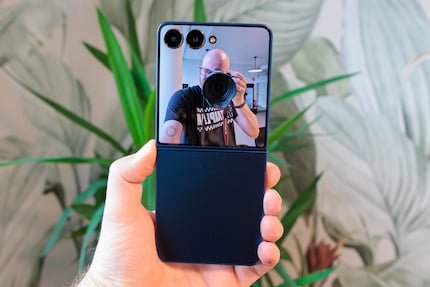
More noticeable is the fact that the Flip 7's external display has become larger. At 4.1 inches - instead of the previous 3.5 inches - it now takes up the entire upper half of the back. The touchscreen has also become larger on the inside and has been given a 21:9 aspect ratio, which makes it wider. The touchscreen now measures 6.9 inches diagonally. The Flip 6 is 6.7 inches and also has a slightly smaller footprint than the entire device.
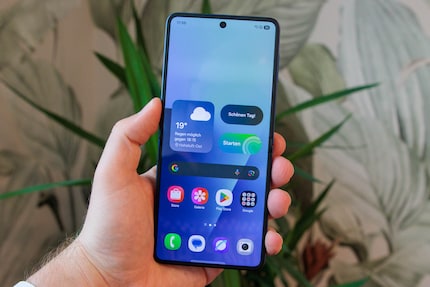
The Galaxy Z Flip 7 is IP48 waterproof. It is designed to withstand up to 30 minutes in 1.5 metres of water. Due to the hinge, the protection against water has moved slightly into the interior of the device and is therefore not dustproof at the outermost point, but only «protected against solid foreign objects with a diameter ≥ 1.0 mm» - according to the official wording.
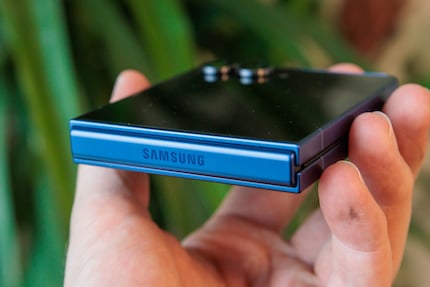
Samsung has placed the fingerprint sensor in the Flip 7's power button, which has become very narrow. When registering, I have to swipe my finger over it. Touching it is not enough. However, it is enough to place your finger on the thin surface to reliably unlock the smartphone during operation. I can choose in the settings whether the screen only switches on the first time I touch it - and I have to press the button a second time to unlock it - or whether both happen at the same time. I can also set up facial recognition for this.
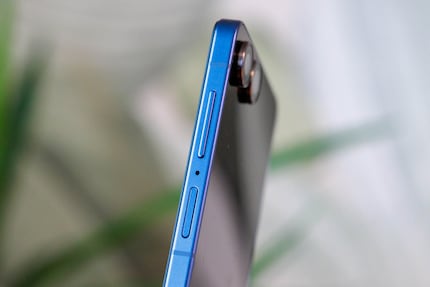
Outside display with widgets and almost all apps
The larger external display of the Galaxy Z Flip 7 naturally invites you to use it even more. However, the question is which apps can be used how well without opening the smartphone. Samsung's standard solution is widgets. These mainly display information from selected apps and offer few opportunities for interaction. You can specify which widgets you see in which formats and in which order in the settings in the submenu «Front display».
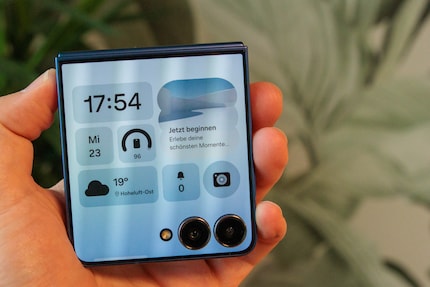
Compared to other clamshell smartphones, however, widgets without many interactions are a disappointment. Fortunately, in the «Labs» section of the settings - where you can try out experimental functions - there is a menu item «Apps allowed on front display (Labs)». I can activate this and then select apps from a list that will be shown on the external display. However, the criteria by which apps qualify for this are unclear.

The selected apps can be started and used on the external display as usual with a tap on the icon. However, they are not always adapted to the small display format. Sometimes the keyboard covers everything or the cameras cover elements. At least the latter can usually be prevented. For example, I can use a small icon at the bottom to select that the app is only displayed above the cameras.
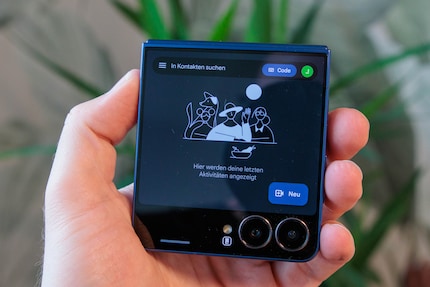
If you want to bring even more apps to the front display despite these restrictions, Samsung refers you to the app «Multistar». This is a widget in which I can get all installed apps - as far as I can see. This isn't always ideal, but it allows me to make video calls, for example, when the half-opened smartphone is in front of me.
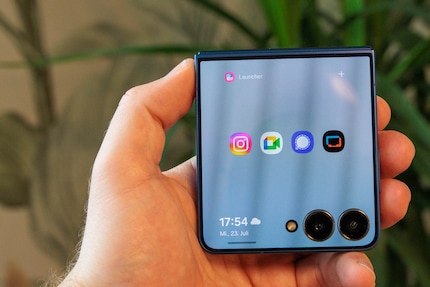
For comparison: Motorola allows all apps on the external display of the Razr 60 Ultra, for example - without any further adjustments. With the Mix Flip, Xiaomi limits the selection somewhat and above all ensures that apps and the cameras do not get in each other's way.
Performance: Exynos instead of Snapdragon
Samsung uses its own Exynos 2500 chipset in the Galaxy Z Flip 7. Unlike the Fold 7 and the S25 models, the Snapdragon 8 Elite is not used. However, I don't notice any speed disadvantage when using the folding smartphone. Everything runs quickly and smoothly. The benchmark comparison reveals that the Exynos can't quite keep up with Qualcomm's top chipset this year, but would have been very good last year - and that's enough for a very usable smartphone.
Larger battery still charges slowly
Samsung has increased the battery capacity of the Flip 7 by 300 mAh to 4300 mAh compared to its predecessor. However, my battery test app has so far failed to work on the device. However, other testers unanimously report an improvement in battery life compared to the predecessor. This should get you through the day.
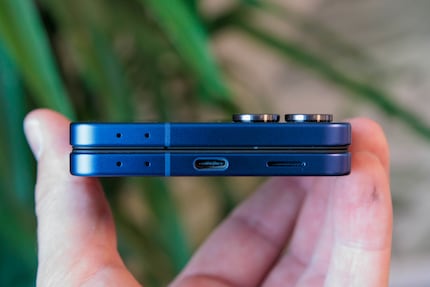
The charging speed is less satisfactory. The Flip 7 accepts a maximum of up to 25 watts. This means it takes almost an hour and a half to fully charge the battery. I don't expect three-digit watt figures, but Samsung should offer the 45 watts of the S25 series in a smartphone with a four-digit price. Alternatively, I can also charge the Flip 7 wirelessly, but at up to 15 watts even slower than via cable.
Camera without changes and still good
Samsung has left the camera setup of the Galaxy Z Flip 7 unchanged compared to its predecessor - including focal lengths, apertures and sensor sizes. This means: On the outside, you have a 50-megapixel main camera and a 12-megapixel ultra-wide-angle camera. Inside, there is a 10-megapixel camera for selfies.
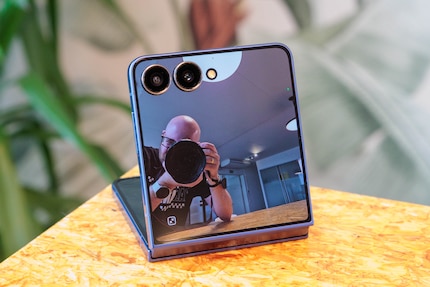
The main camera does not let clouds and rain spoil the display of vibrant colours. The raindrops do, however, spoil the level of detail somewhat.

It is definitely worth activating night mode in the dark. It ensures better illumination and a higher level of detail, although the difference is greater with the ultra-wide-angle camera than with the main camera.
But the most important question is probably: How much better are the selfies with the outer cameras compared to the camera in the inner display? It already delivers good image quality - even in twilight.

The only thing that stands out in comparison is that the main camera handles the colours slightly differently and chooses a square image format.

With the ultra-wide-angle camera, you have to be very careful not to take a picture of your own finger. It's just so damn close to the camera when you're holding the Flip 7 comfortably in your hand to look at the external display.
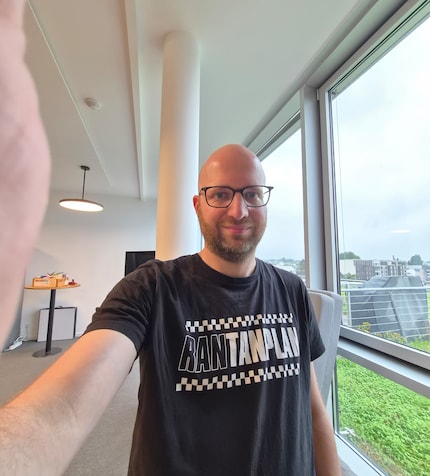
The advantages of the external cameras become clearer in the dark. With night mode activated, the selfie with the main camera is simply better.


The Flip 7 does not have a telephoto camera. However, the digital zoom does a better job than I expected. The four-fold digital magnification is easy to use, as is the ten-fold magnification with limitations in terms of image quality. Artefacts and inaccurate pixels are already noticeable here.


Overall, I am impressed by the Flip 7's cameras, which deliver a high level of detail and colourful images even in difficult lighting conditions. The difference in quality between the ultra-wide-angle and main camera is small and the selfie camera also delivers good images. The other cameras are only superior in the dark and when using night mode.
Android 16 with a lot of Samsung
Samsung delivers the Galaxy Z Flip 7 with Android 16. The manufacturer has provided Google's operating system with its One UI 8 user interface, which includes many Samsung apps and Galaxy AI in addition to visual customisations. You can use all of Samsung's AI tools on the flip smartphone. Gemini even works on the external display.
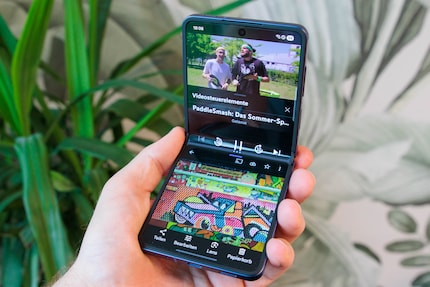
Samsung promises to provide the Flip 7 with software and security updates for seven years. Now the folding display just has to last that long.
In a nutshell
Samsung's folding smartphone is getting better and better
Everything that Samsung has changed in the Galaxy Z Flip 7 compared to its predecessor - larger external display, larger battery and thinner design - makes the flip smartphone better. Although the manufacturer has left the camera system unchanged, it continues to impress me with its good image quality.
Although the Exynos processor performs worse in benchmarks than the Snapdragon in the Fold 7, I don't notice any disadvantages when using the Flip 7. No wonder, as it is on a par with the top chipset from 2024. What bothers me more is the slow charging speed of the battery.
Not every app is optimally adapted to the external display, but Samsung has found solutions to make them usable there. Otherwise, you can expect the entire package of services and apps from Samsung and all the AI tools from Galaxy AI. Samsung has garnished the whole thing with a long update period.
Pro
- Large external display
- Good battery life
- Long update period
- powerful chipset
Contra
- Only widgets optimised for external display
- no telephoto camera
- Slow charging speed

As a primary school pupil, I used to sit in a friend's living room with many of my classmates to play the Super NES. Now I get my hands on the latest technology and test it for you. In recent years at Curved, Computer Bild and Netzwelt, now at Digitec and Galaxus.



